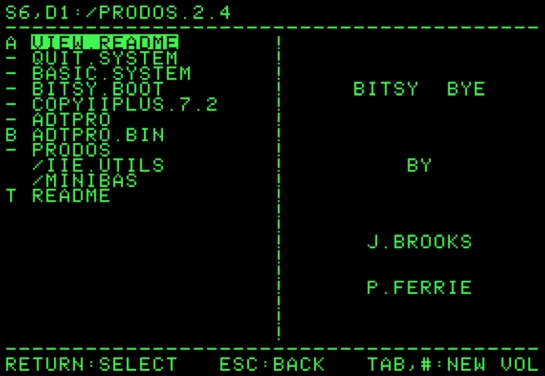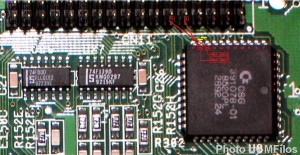2 x ORIC-1 Repair
ORIC-1 Repair [1 of 2]
Defect:
- Garbage boot Screen and then another Garbage screen (see photo).
Repair:
- Replaced 1 x CPU 6502 (IC5)
- Replaced 1 x RAM HM4864P (IC12)
Gallery of the repair:
————————————————————————————————————————
ORIC-1 Repair [2 of 2]
Defect:
- No audio.
Repair:
- Replaced 1 x Electrolytic Capacitor interrupted of 220uF 10v (C1)
Gallery of the repair:
HDMI Male To VGA Female Converter
Spending only 4.70 Euro including postage this interface works good, the conversion from Digital to Analog works perfectly without delays or video artifacts.
source: ebay.com
Commodore 64 (ASSY 250407) Repair
Commodore 64 (ASSY 250407) Repair
Defect:
- Black screen and a noisy background sound .
Repair:
- Replaced 1 x MOS 906114 (PLA) U17
- Replaced 1 x MOS 6581 (SID) U18
Commodore Amiga 500 (ASSY 312510) Repair
Commodore Amiga 500 (ASSY 312510) Repair
Defect:
- Garbage boot Screen (see photo).
Repair:
- Replaced 1 x FAT Agnus 8371
Gallery of the repair:
Logitech Dual Action Arcade inside a ION Icade
As you can see this is a control pad of the Ion iCade case. It is designed to fit an iPad and has a built in stand for holding it.
The iCade is designed to work as a Bluetooth keyboard of sorts with an iPad.
It uses a standard arcade control wiring and is very easy to modify it to work with any interface can convert the signal from Analog to USB, like the PCB of a Logitech Dual Action joypad.
Gallery:
ProDOS 2.4.1 by J.B. Brooks

A software developer John Brooks released what is clearly a work of pure love: the first update to an operating system for the Apple II computer family since 1993.
ProDOS 2.4, released on the 30th anniversary of the introduction of the Apple II GS, brings the enhanced operating system to even older Apple II systems, including the original Apple ][ and ][+.
Note: ProDOS 2.4 is now updated to ProDOS 2.4.1.
ProDOS 2.4 adds new features for all Apple II computers, including the 1977 Integer ROM Apple II. The last release, version 2.0.3, was released in 1993 by Apple computer, 23 years previously.
Download: ProDOS 2.4.1 by J.B. Brooks (DSK) (996)
source: archive.org
Photo Gallery of my Retro Collection
Photo Gallery update of my Retro Collection / Retro Trash.
Many things in the photos are not visible because are in hidden places or deliberately hidden.
I seem to have accumulated a lot of things in these long years and this is a good time to meditate what to do and what not to do, absolutely do not sell anything or donating, but also not continue to accumulate, in fact from a few months i’m moving just on repairs and modding and i must say that i feel much better.
Photo Gallery:
Commodore Amiga 600 – External Floppy Drive as DF0
Commodore Amiga 600 – External Floppy Drive as DF0.
This mod is very easy, just follow the schematic attached to this post.
Gallery:
Schematic:
Commodore A501 Leaked Battery Clock
Works that have been made:
- Cleaning the leaked acid (KONTAKT PLCC)
- Sprayed a thin layer of insulating lacquer (DUE-CI V-66)
Gallery:
Atari Ultimate 1MB Firmware Update to the latest version
Fortunately a year ago i have also updated the CPLD code (Xilinx) of the Ultimate 1MB to version v2, needed for this update!
Gallery:
source: atariage.com
Texas Instruments Extensa 460
Texas Instruments TI-99/4 2 x Power Supply Fixed
2 x Texas Instruments TI-99/4 Power Supply Fixed
- Removed the RIFA Filter Capacitor, one exploded.
Gallery:
Texas Instruments TI-99/4 Fixed
Texas Instruments TI-99/4 Fixed
Defect:
- Garbage screen on startup immediatly or after a couple of minutes.
Fix:
- This defect is very similar to the one of the Coleco Vision console.
The problem are the pins oxidized of the power switch, i have sprayed R-11 and the problem it’s disappeared completely.
I left turned on the computer for more than 2 hours and i have made a 50 x power cycle (ON/OFF) and the problem is no longer appeared.
Note:
I thought there had to be a VDP RAM problem with a diagnosis made remotely without having the TI-99/4 in the laboratory.
To avoid using the lame RF modulator i have used a standard Commodore 64 composite cable that works very well with a NTSC composite video output.
Gallery:
2 x Commodore 64 Repair
Commodore 64G repaired (1 of 2)
Defect:
- Black screen
Repair:
- Replaced 1 x MOS 7707 (7406) U8
Note:
- The motherboard has been repaired several times, the technician probably in a previous life was a butcher.
Commodore 64 repaired (2 of 2)
Defect:
- Garbage screen but runs programs perfectly.
Repair:
- Replaced 1 x MOS 906114 (PLA) U17





Recent Comments